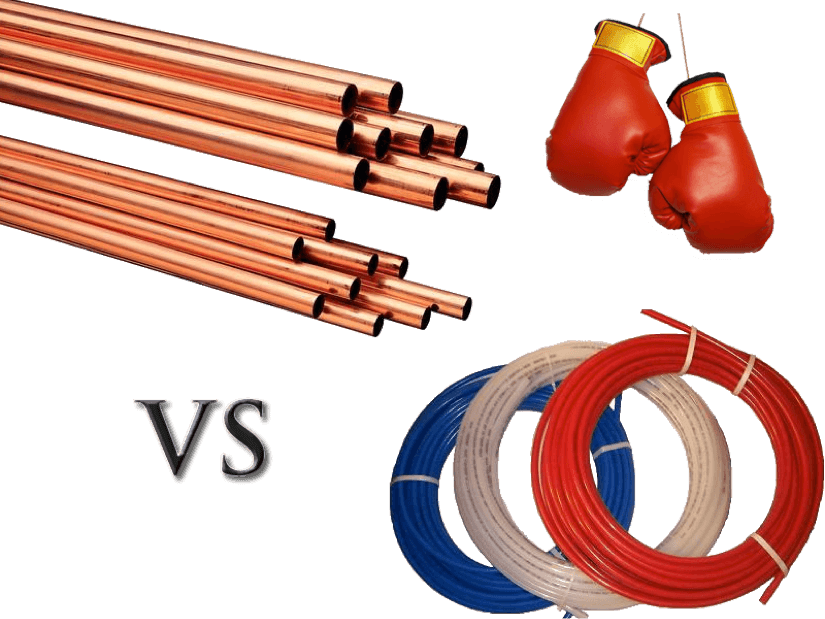Best Material for Your Home Repiping
Given that home piping systems have life expectancies that in many cases exceed those of the homeowners, it isn’t likely you’ll need to think about repiping your home anytime soon. That is, unless you have an old home or one where there are high levels of hard water (making the pipes more prone to deteriorate and leak). Or if you have consistent low water pressure levels, rust-colored water and/or consistent scalding water even when the cold water is turned on. Or if you haven’t been careful caring for your pipes properly and there were a few instances of clogged lines and leaks.
And, sometimes, stuff just happens.
When there’s a crack or flaw in your piping system, or if the pipes are worn down, it’s all too easy for fungi, debris, and other materials to slip into your drinking and bathing water. If your piping system is underground, you could unknowingly be losing thousands of gallons and dollars every day.
In any event, if your pipes are leaking, damaged and/or corroded beyond simple spot repair and you’re considering a repiping job, the first thing you need to ask yourself is: pex or copper?
Which is better? As with most things, the answer is, it depends. Each has its pros and cons. In this post, let’s take a look at some key considerations to help you choose whether pex or copper repiping is best for your home and your needs.
What’s the Difference Between Pex and Copper Piping?
Pex piping is a flexible material that’s easy to install. It is made of cross-linked polyethylene, and ranges in size from 1/4-inch to 4-inch. The most common sizes, however, are 1/2-inch, 3/4-inch, and 1-inch.
Copper is long popular for hot and cold water piping, as well as within home HVAC (Heating Ventilation Air Conditioning) systems. There is soft copper and rigid copper, both of which are ideal for different piping purposes. Soft copper is ideal for air conditioners and heat pumps; rigid copper is more commonly used for water lines because it is heated and bent without cracking.
Both are safe and appropriate for residential piping. In trying to decide between one or the other, it’s hard to make a “wrong” decision. What determines your choice are the details of your project and your budget. To weigh the pros and cons, let’s take a look at the best use for both materials.
Pex Pipe Pros
The pex pipe pros (try saying that three times fast!) include that pex piping:
Pex Pipe Cons
Nothing is perfect, at last not perfect for all situations. The cons to consider are that pex piping:
Copper Pros
Copper costs more than Pex, but copper also outlasts Pex. Other copper pros include:
Copper Pipe Cons
Again, nothing is perfect. The cons of copper piping include:
Choosing the Right Material
So which is better for your home repiping project? Well, there’s no wrong choice. It depends on the location and use of the repiping, the quality of the water supply and the type of project.
If you’re performing the repiping job yourself, it is easier to use pex piping material. Also, if you are only repiping a specific area where it is hard to maneuver, such as a crawlspace or a room with a lot of corners, plex is more flexible and therefore the better choice. This makes installation faster and even safer. In addition, pex piping generally doesn’t require much maintenance.
These same advantages of pex piping apply to small remodeling projects. In addition to the flexibility that allows you to work in less space where you have less room to maneuver, cleaning up is quicker because you don’t need to rip out entire walls, floors and/or ceilings to route the pipe.
On the other hand, if the water running through your pipes is heavily acidic or chlorinated, copper pipe installation is best. Copper is also the better choice when the new pipes are routinely used to run water over 180 degrees Fahrenheit in temperature.
For new construction, copper is preferred. Open walls and ceilings make it easy to lay copper pipe. Plumbers also prefer copper because of its 100-year lifespan. While it is more expensive than pex, your plumbing isn’t something you should scrimp on for new construction. Copper is usually preferred for water supply lines and heating systems but plex is most often used for drain or waste lines because copper corrodes over time.
Ultimately, it’s up to the homeowner to decide where to spend the construction budget. That said, your plumber can best advise you of what materials work best and how an up front cost might eventually pay off better over time than a less expensive option.
When to Get a Plumber
Unless you feel extremely confident in your own handy skills and/or your project is relatively small, repiping, whether using copper or plex, is best performed by a professional plumber. Benjamin Franklin Plumbing is highly experienced at repiping, as well as performing a range of plumbing repairs.


